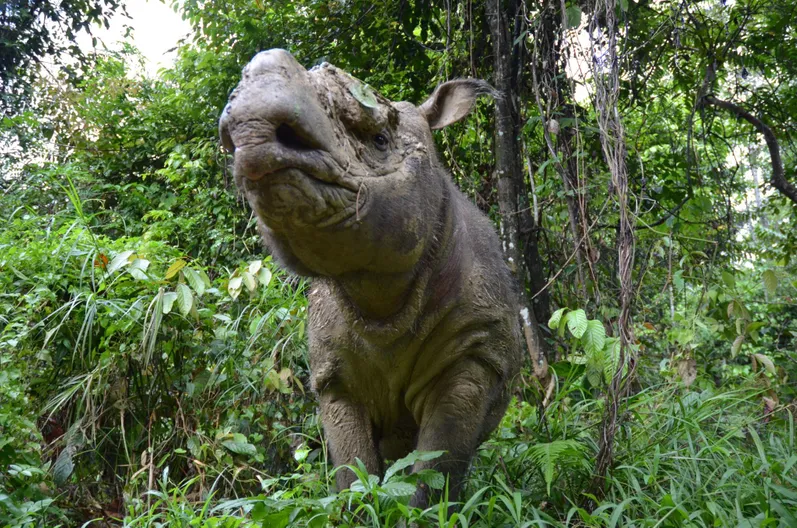Researchers at the Max Delbrück Center have made progress in an effort to save the Sumatran rhinoceros from extinction by growing stem cells and mini-brains from the skin cells of Kertam, the last male Sumatran rhino in Malaysia, who died in 2019. The aim is to use these cells to produce sperm cells for reproduction.
The Sumatran rhinoceros, the smallest and oldest species of rhinoceros, used to be found throughout East and Southeast Asia; but poaching and habitat destruction have greatly reduced the population, with only a few dozen individuals left in the rainforests of Sumatra and Borneo. The limited number of remaining individuals makes it difficult for them to find mating partners, contributing to the species endangered status, as per WWF.
This rhinoceros species is the only surviving species of rhinoceros that has hair. It has been considered extinct in Malaysia since 2019, following the death of the male Kertam and, a few months later, the female Iman.
Saving Using Stem Cells
However, a team of scientists from the Max Delbrück Center in Berlin, led by Dr. Vera Zywitza and Dr. Sebastian Diecke, are working on a plan to use skin cells from deceased Sumatran rhinos to create stem cells, which can then be turned into egg and sperm cells for assisted reproduction. The goal is to fertilize the eggs in the laboratory using sperm from Kertam and other deceased or infertile individuals, and then have the resulting embryos carried to term by surrogate rhino mothers.
The team led by Dr. Vera Zywitza as well as Dr. Sebastian Diecke has reported success in generating induced pluripotent stem cells (iPS cells) from the skin samples of Kertam, the last male Sumatran rhinoceros in Malaysia, according to an article published in the scientific journal iScience. These iPS cells can divide indefinitely and can transform into any type of cell in the body. The team used these cells to grow "mini-brains," also known as brain organoids, for their study.
The technology platform used to create the stem cells was developed as part of the BioRescue research project for the even more critically endangered northern white rhinoceros, of which only two females remain, living in a Kenyan wildlife reserve. The BioRescue project was funded by the German Federal Ministry of Education and Research, and the research team at the Leibniz Institute for Zoo and Wildlife Research in Berlin, headed by Professor Thomas Hildebrandt, also played a significant role in the project. The current study on the Sumatran rhinoceros has benefited greatly from the knowledge gained through the BioRescue project, as mentioned by Dr. Vera Zywitza.

ALSO READ : Endangered Sumatran Rhinoceros Displays Surprisingly Good Health, Genome Research Reveals
Kertam's Legacy
Dr. Vera Zywitza stated that everyone involved in the current study was surprised and pleased to find that the methods used to turn the skin cells of northern white rhinos into stem cells also worked well with Sumatran rhinos. Under the microscope, the stem cells of both rhino species were similar to human iPS cells. However, there were some species-specific differences. For example, Kertam's iPSCs could not be cultivated without feeder cells, which release growth factors that help to keep stem cells in a pluripotent state, while this was not an issue with the northern white rhino iPS cells.
In addition to helping to preserve the Sumatran rhinoceros species, the stem cells obtained from Kertam's skin could also be used for research purposes. According to Dr. Vera Zywitza, iPS cells from exotic animals, such as the Sumatran rhinoceros, can provide valuable insights into the evolution of organ development. To demonstrate this, Dr. Silke Frahm-Barske, a scientist in Dr. Diecke's investigation group developed brain organoids from the skin cells. According to Dr. Silke Frahm-Barske, the mini-brains produced from the Sumatran rhinoceros iPS cells are similar to those obtained from mice, humans, and non-human primates.
However, the team had to use slightly different techniques to generate the brain organoids from the human and rhino iPS cells. Frahm-Barske said that the team was very pleased to see that the stem cells as they generated from the Sumatran rhino formed organoids quite similar to those of humans. The next goal of the research team is to use Kertam's iPS cells to grow sperm suitable for artificial insemination. This process is more difficult than growing brain organoids, according to Dr. Vera Zywitza.
Obtaining and Cultivating the Cells
She explained that to obtain sperm cells, the team needs to use the iPS cells to cultivate primordial germ cells, which are the precursors of eggs and sperm. The team also plans to obtain iPS cells from other Sumatran rhinos. Reproduction expert Thomas Hildebrandt believes that efforts like these are necessary because measures are being taken in Indonesia to preserve the Sumatran rhino population by bringing the remaining individuals together in wildlife reserves, but these efforts may not be enough.
Hildebrandt addressed that females that have not been pregnant for a long time may become infertile due to cysts on their reproductive organs or may be too old to bear young. Therefore, assisted reproduction techniques, such as artificial insemination, may be necessary to help preserve the species.
Dr. Vera Zywitza emphasizes that, although their work is attempting to make the seemingly impossible possible by ensuring the survival of animals that would otherwise probably go extinct, it should remain an exception and not the rule. She points out that, while the research being conducted in the lab may be able to make a small contribution to saving these rhinos from extinction, the protection and conservation of the animals' remaining habitats are at least equally important.
RELATED ARTICLE : Rhinoceros Going Extinct? Genome Analysis of Five Living Rhino Species May Help Save Them
Check out more news and information on Rhino in Science Times.
© 2025 ScienceTimes.com All rights reserved. Do not reproduce without permission. The window to the world of Science Times.












